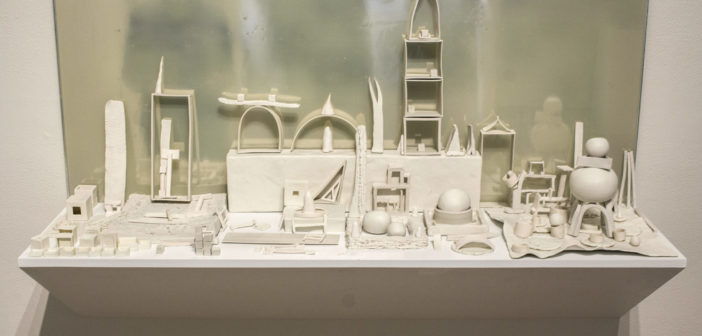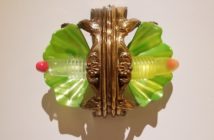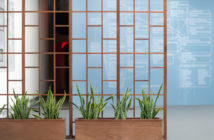Providence artist Allison Paschke can be disobedient in museums. Sometimes, she’ll find a sculpture or object irresistible, and smooth her hand carefully over its surface. In her latest exhibit at AS220 Project Space, Paschke extends this “mischievous glee” to her viewers. She offers a rejoinder to the usual gallery signage, the typical prohibitions on contact, and invites the audience to please touch with a series of four interactive and engaging installations.
Upon this playground, one can abandon analysis and reclaim instinct. Paschke wants people to approach her art as a child would, to learn by feeling. As in childhood, the body again becomes a primary means of understanding physical reality. Paschke has been summoning the “inner child” since 2004 when she first welcomed audiences to toy with porcelain elements she had installed in the corner of a gallery.
“I found that when people touch objects, they spend more time with them and they look much more carefully than if they were just walking past each piece, as in a typical gallery or museum,” Paschke says. “They develop a personal, intimate relationship with the elements.”
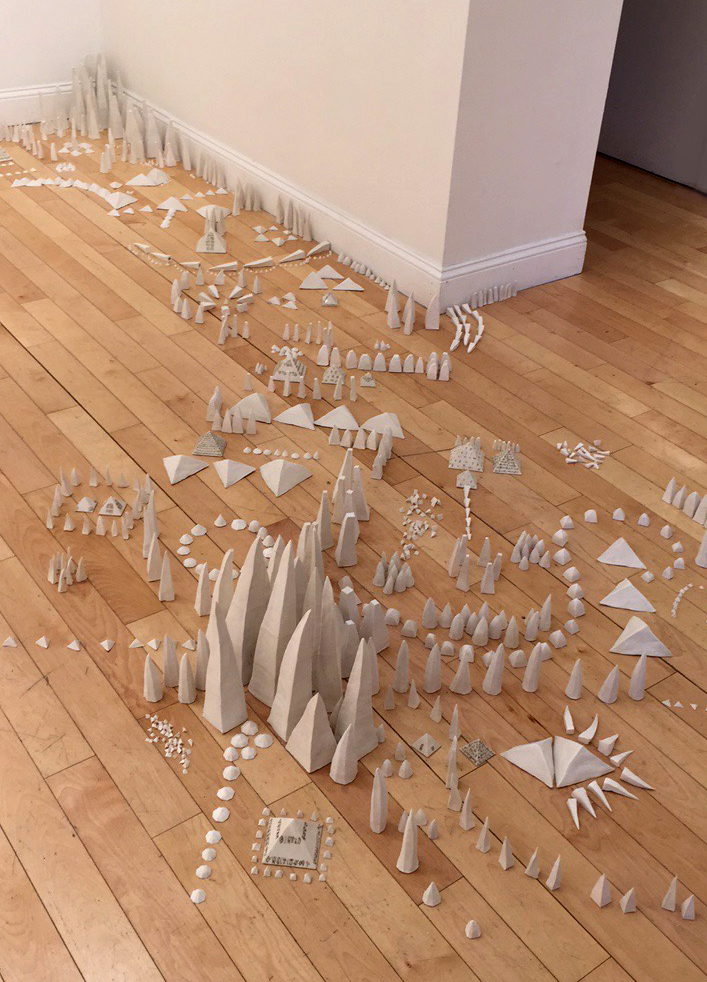
Hypatia
Photo: Alyssa Coffin
One could certainly spend minutes, if not hours, absorbed in Hypatia, the show’s biggest and most sprawling piece. Nearly 3,000 porcelain spires, pyramids, cones, and towers rise from the gallery floor like the remnants of a forgotten and impossibly tiny city. Guests can reposition these components however they please. Perhaps the most popular piece, Paschke has witnessed a broad spectrum of reactions. “Some people like to imagine themselves as Godzilla,” she says, while others are brief and hesitant in their interactions.
The number of potential arrangements is exciting, but Hypatia can be a bit unforgiving on the knees—unless one adopts a more childlike position: crossed legs or lying flat on one’s stomach. The shelf-installed build can be more comfortable, allowing participants to tinker with an assortment of doughy porcelain charms: rings, eggs, ladders, boxes, planks or confetti-like shreds. A mirrored panel backdrops the action, heightening the interactivity with the observer’s reflection. During my visit, however, I found myself totally absorbed in the Lilliputian architecture, barely noticing the mirror.
Reflection also plays a role in shuffle, the most chromatic installation here. A departure from Paschke’s typically restrained palette, visitors overlap and reorganize sheets of colored resin and acrylic gels, providing instant color field paintings. The vibrant slabs sit on a shelf, propped against a row of mirrors, but once again the appeal is hardly the viewer’s image. The mirrors instead respond to the central activity, a kind of minimalist-painting-cum-performance.
Luminous and lucid illusions continue in add and subtract, wherein Paschke serves up a slew of yolk-like splats. These resin forms are mostly transparent, but the light teases out hints of golden yellow. Visitors can hang and stack these perforated, shining splotches on insect pins in the wall. Layering the forms reveals a visual arithmetic; color deepens or fades with each decision one makes. Light tickles the eyes, and one is compelled to find more combinations of glow and shadow in this eggy array.
Common to all four installations is the activating presence of the audience, whose interventions are not only tolerated but necessary. Paschke conjures the inhabitants in these fantasy lands, but the visitor is tasked with their governance. Anonymous hands rearrange the landscape constantly. Unspoken efforts are built upon, ignored or overwritten by subsequent architects.
“I’m…allowing others to make the work better than what I’d made myself,” Paschke says. The pieces’ lowercase titles and the exhibit’s titular please further Paschke’s intentions of “express[ing]my humility.”
The collaborative nature of these installations could even be seen as democratic, with everyone given access to create, express, or narrativize. Still, no single interpretation or configuration reigns for long. An impermanence emerges, amplifying the preciousness of porcelain.In her 30 years of working with ceramics, the medium’s fragility has long fascinated Paschke.
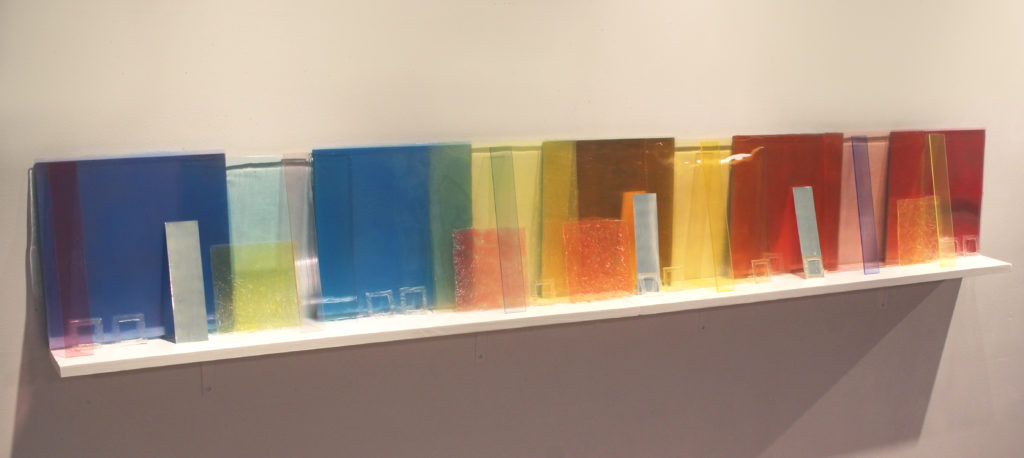
shuffle
Photo: Alyssa Coffin
The resin is relatively new to Paschke’s oeuvre, a sort of glaze à la carte. (She prefers clay unadorned and avoids glazing it.) She first discovered it when her husband was making boats and was drawn to its radiant yet subtle color. It’s not the most accommodating medium, yielding “glippy glop all over the place” and susceptible to ruin by “stray cat hairs.” Paschke finds “the immediacy and range of colors and surfaces it can give” worth the trouble—a thrill she shares with shuffle.
Paschke’s material choices and embrace of the crowd relay her influences, both visual and theoretical. In its potent saturation, shuffle evokes Mark Rothko, one of her earliest inspirations. A teenaged Paschke found “the richness and power” of Rothko’s coloration an emotional intoxicant, capable of unsettling her stomach. Hypatia and build, meanwhile, echo the bleached ceramics of Ruth Duckworth, whose achromatic forms seem kindred to Paschke’s. As for the structural, constructive nature of her work, Paschke cites Sol Lewitt’s systematic minimalism.
Lewitt’s work is more superficially pristine, but he shares a certain chaos with Paschke. Her work is more permissive, its revision and disorder driven by the public, suggesting a creation willingly unfinished by its maker. The work is open to multiple narratives, logics or modes of reason. Paschke gives the viewer a raw beauty, something to be unearthed and fleshed out through the therapeutics of play.
“I want to make work that heals people from all the horrors, instead of speaking about them directly or passing on the pain they cause,” says Paschke.
This prioritizing of beauty over explicit politics evinces the influence of critics like Dave Hickey. In a 1995 interview, Hickey proposed a “more secular and aggressive idea of beauty,” an appreciation of art based on sensuous pleasure and sustained engagement. Hickey’s positive evaluation of beauty was once hotly contested, but there are numerous rhetorical salvos against the idea of beauty as apolitical or regressive. In a clever reading of Kant, Tobin Siebers foregoes the philosopher’s typical characterization as authoritarian and duty-bound to argue for a liberating aesthetics. Beautiful things, he writes, indicate otherness, and “[make]the individual subject aware of the fact that other things exist beyond his or her control.”
Siebers’ exegesis of Kant could just as easily apply to Paschke’s installations:
“Beauty is a vision of a plural universe in which self and other necessarily meet—a universe in which one must contend with others and other logics, with creations that wrench themselves free from the hand of their creator, with forms that seem whole apart from us, with purposes beyond our meddling and understanding.”
Childhood is obviously a time when the relations between subject and object are less definite. The Other is not as severely repudiated as it can be in adulthood, and might even be considered contiguous with one’s self. For psychoanalyst D.W. Winnicott, play vitalized all creativity and makes possible culture. Play is not “inner psychic reality,” nor is it “the external world.” It is “inherently exciting and precarious” for its blurring of subject and object.
Paschke encourages returning to this headspace and recovering the curative powers of beauty and play. Paschke’s 78-year-old mother certainly did. She made “penguins” at the exhibit’s opening. “She had moved some smaller rounded towers close to some similar but taller towers so that they looked like Emperor penguins sheltering their newly hatched chicks,” Paschke says.
That’s not only a cute anecdote but an apt summary of what happens in Paschke’s work. The beautiful and the imagined are made touchable, as are the contributions of the exhibit’s other visitors. Rather than getting lost in this stream of collective action—the parade of porcelain across a hardwood floor, or the light dancing through colored resin—the self is enriched. Play again orders both the inside and the outside in vivid and fulfilling ways.

